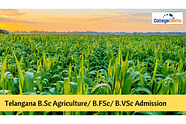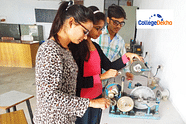The AP EAMCET 2025 syllabus includes topics like laws of motion, thermodynamics, motion in a plane, organic and inorganic chemistry, algebra, trigonometry, probability, and others. For a detailed syllabus go through the article below.

AP EAMCET 2025 Syllabus has been released by APSCHE on the official website. Candidates should check the syllabus of AP EAPCET 2025 before starting their preparation. This will not only help them in advanced preparation but also allow them to spare more time for topics that carry maximum weight. The AP EAMCET 2025 physics syllabus comprises 9% questions from the chapter thermodynamics, 6% questions from work, energy, and power, 5% questions from motion in a plane, and so on. On the other hand, the important chapters in mathematics are probability, vectors, calculus, and integral calculus. This article is a complete syllabus guide for the AP EAMCET 2025 aspirants. Check AP EAMCET Preparation Tips 2025 here!
Latest Updates:
- AP EAMCET 2025 Application Form can be filled till May 1, 2025, by paying a late fee of INR 1000, at cets.apsche.ap.gov.in/EAPCET/.
- AP EAMCET 2025 Exam will be conducted from May 19 to 20, 2025, for Agriculture & Pharmacy and from May 21 to 27, 2025, for Engineering.
AP EAMCET 2025 Syllabus PDF
Download the Syllabus PDF of AP EAMCET 2025 here.
AP EAMCET 2025 Physics Syllabus
The AP EAMCET 2025 physics syllabus includes topics such as units and measurements, motion in a straight line, oscillations, mechanical properties of solids, and others. To have a look at the full syllabus, refer to the table below.
Chapter Number | Chapter Name | Important units |
|---|---|---|
Chapter 1 | Physical world |
|
Chapter 2 | Units and measurements |
|
Chapter 3 | Motion in a straight line |
|
Chapter 4 | Motion in a plane |
|
Chapter 5 | Laws of Motion |
|
Chapter 6 | Work, energy and power |
|
Chapter 7 | System of particles and rotational motion |
|
Chapter 8 | Oscillation |
|
Chapter 9 | Gravitation |
|
Chapter 10 | Mechanical properties of solids |
|
Chapter 11 | Mechanical properties of fluids |
|
Chapter 12 | Thermal properties of matter |
|
Chapter 13 | Thermodynamics |
|
Chapter 14 | Kinetic theory |
|
Chapter 15 | Waves |
|
Chapter 16 | Ray optics and optical instrument |
|
Chapter 17 | Wave optics |
|
Chapter 18 | Electric charges and fields |
|
Chapter 19 | Electrostatic potential and capacitance |
|
Chapter 20 | Current electricity |
|
Chapter 21 | Moving charges and magnetism |
|
Chapter 22 | Magnetism and Matter |
|
Chapter 23 | Electromagnetic induction |
|
Chapter 24 | Alternating current |
|
Chapter 25 | Electromagnetic waves |
|
Chapter 26 | Dual nature of radiation and matter |
|
Chapter 27 | Atoms |
|
Chapter 28 | Nuclei |
|
Chapter 29 | Semiconductor electronics |
|
Chapter 30 | Communication systems |
|
AP EAMCET 2025 Mathematics Syllabus
The AP EAMCET 2025 mathematics includes important topics like definite integrals, trigonometry, integration, circles, limits and others. Take a look at the entire mathematics syllabus below.
Chapter Number | Chapter Name | Important units |
|---|---|---|
Chapter 1 | Algebra |
|
Chapter 2 | Trigonometry |
|
Chapter 3 | Vector algebra |
|
Chapter 4 | Measures of dispersion and probability |
|
Chapter 5 | Coordinate geometry |
|
Chapter 6 | Calculus |
|
AP EAMCET 2025 Chemistry Syllabus
The chemistry syllabus for the AP EAMCET included topics like chemical bonding and molecular structure, atomic structure, thermodynamics, hydrogen and its compounds and many others. To have a look at the detailed chemistry syllabus refer to the table below.
Chapter Number | Chapter Name | Important units |
|---|---|---|
Chapter 1 | Atomic structure |
|
Chapter 2 | Classification of elements and periodicity in properties |
|
Chapter 3 | Chemical bonding and molecular structure |
|
Chapter 4 | States of Matter |
|
Chapter 5 | Stoichiometry |
|
| Chapter 6 | Thermodynamics |
|
| Chapter 7 | Chemical equilibrium and acid bases |
|
| Chapter 8 | Hydrogen and its compounds |
|
| Chapter 9 | S-block elements |
|
| Chapter 10 | P-block elements group 13 |
|
| Chapter 11 | P-block elements group 14 |
|
| Chapter 12 | Environmental chemistry |
|
| Chapter 13 | Organic chemistry |
|
| Chapter 14 | Solid state |
|
| Chapter 15 | Solutions |
Mass by volume percentage
|
| Chapter 16 | Electrochemistry and chemical kinetics |
|
| Chapter 17 | Surface chemistry |
|
| Chapter 18 | P-block elements group 15 |
|
| Chapter 19 | D and F block elements |
|
| Chapter 20 | Polymers |
|
| Chapter 21 | Biomolecules |
|
| Chapter 22 | Chemistry in everyday life |
|
| Chapter 23 | Halo alkanes and Halo arenes |
|
| Chapter 24 | Organic compounds |
|
| Chapter 25 | Organic compounds containing nitrogen |
|
If you are looking for admission into the
Top Private Engineering Colleges In India 2025
across the country, you can just fill
Common Application Form
on our website. It is a single application form for admission into various universities. We hope the above information was helpful. For more updates on AP EAMCET 2025 check out our official website www.collegedekho.com.
Are you feeling lost and unsure about what career path to take after completing 12th standard?
Say goodbye to confusion and hello to a bright future!

FAQs
Generally, both AP EAMCET and TS EAMCET exams are considered to have a moderate difficulty level, evaluating candidates on fundamental concepts in the subjects of Physics, Chemistry, and Mathematics/Biology.
The highest weightage topics for AP EAMCET Mathematics include Calculus, Algebra, Vector algebra, Trigonometry and Probability. The highest weightage topics for AP EAMCET Physics are Current Electricity, Thermodynamics, Electrostatic Potential and Capacitance and Oscillations.
To score 100 marks in the AP EAMCET 2025 entrance exam, candidates are required to create a structured timetable. Candidates must prioritize practicing previous years' question papers, mock tests, and sample papers. Candidates must emphasize upon high-weightage chapters and refer to AP EAMCET best books 2025 for complete syllabus coverage.
AP EAMCET 2025 entrance exam has a moderate difficulty level, evaluating candidates on fundamental concepts in the subjects of Physics, Chemistry, and Mathematics/Biology.
Some of the recommended books for the AP EAMCET 2025 Mathematics preparation are Class XI & XII Mathematics by R.D. Sharma, EAMCET Mathematics (Andhra Pradesh & Telangana) by Arihant Experts, Vector & 3D Geometry by Amit M. Agarwal and Coordinate Geometry by S K Goyal to name a few.
Every question from all sections in the AP EAMCET 2025 exam carries one mark and for each correct option, candidates will be awarded 1 mark. There is no negative marking in the AP EAMCET 2025 exam i.e. 0 marks will be deducted for incorrect answers.
Each section in the AP EAMCET 2025 exam comprises 40 questions. A total of 160 questions are asked in the examination from the subjects of Physics, Chemistry, Botany, and Zoology. Each question will carry 1 mark. There is no negative marking in the AP EAMCET exam 2025.
120 marks in the AP EAMCET 2025 exam can be considered to be a good score whereas a 70+ score is considered to be an average score in the AP EAMCET exam.
Was this article helpful?


















Similar Articles
Polytechnic Courses 2025: Details, Fees, Eligibility, Admission Criteria
TS POLYCET 2025 (May 13): Hall Ticket, Pattern, Preparation, Result
AP ECET 2025: Exam Date, Syllabus, Eligibility, Exam Pattern
TS EAMCET 2025: Result (Out), Exam Dates (April 29 to May 4), Eligibility, Pattern, Preparation
TS EAMCET 2025 Exam Date (May 2 to 4): Result (Out), Counselling (Soon)
COMEDK UGET 2025 Exam Dates: Admit Card, Exam (Shift 2 Over), Result Date, Counselling